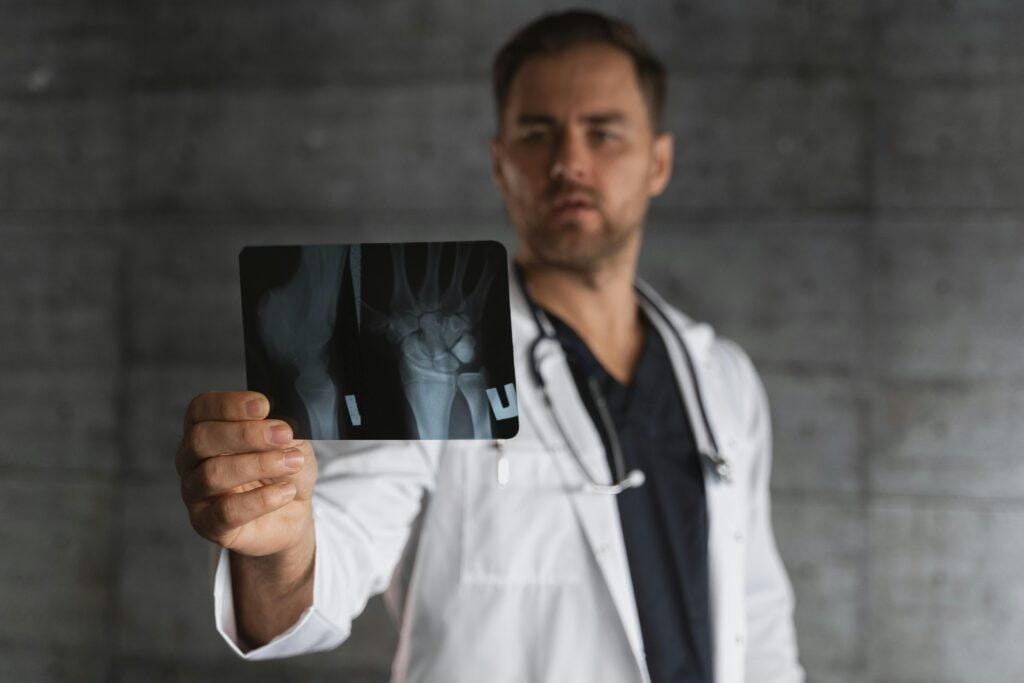Introduction to Fractures
A fracture refers to any break in the continuity of a bone. The term encompasses a wide range of injuries—from severe open, comminuted fractures to subtle undisplaced stress fractures. Fractures are classified based on several key characteristics: Fracture Types and Patterns
- Aetiology (cause)
- Morphology (pattern)
- Severity (comminution, soft tissue/joint involvement)
- Location (affected bone part)
- Displacement (bone fragment movement)
This guide explores different fracture types, their causes, and clinical significance.

Fracture Aetiology: Causes of Bone Breaks
1. Traumatic Fractures
These result from direct or indirect force applied to normal bone, such as falls, collisions, or sports injuries.
2. Pathological Fractures
Occur in abnormal or diseased bone (e.g., tumors, osteoporosis) due to minimal trauma. Common causes include:
- Osteoporosis (reduced bone density, leading to hip, wrist, or spine fractures)
- Osteomalacia (bone softening from vitamin D deficiency)
3. Fatigue (Stress) Fractures
Caused by repetitive stress on normal bone, often seen in athletes or military recruits (e.g., march fractures in the second metatarsal).
Fracture Morphology: Patterns of Bone Breaks
1. Transverse & Oblique Fractures
- Transverse fractures: Caused by direct impact (e.g., a blow).
- Oblique fractures: Result from angled force, often with a butterfly fragment.
2. Spiral Fractures
Due to rotational forces, common in sports injuries (e.g., tibia, humerus).
3. Avulsion Fractures
Occur when ligaments or tendons pull off a bone fragment (e.g., ankle inversion causing a fifth metatarsal avulsion).
4. Impaction Fractures
Bone collapses under compression, often in joints (e.g., tibial plateau fractures).
5. Pediatric Fractures
Children’s bones are more flexible, leading to unique fractures:
- Torus (buckle) fractures: Compression-side buckling.
- Greenstick fractures: Incomplete breaks with bent bone.
Fracture Severity: Assessing Damage
1. Open (Compound) Fractures
Bone penetrates the skin, high infection risk.
2. Comminuted Fractures
Multiple fragments indicate high-energy trauma, increasing non-union risk.
3. Intra-Articular Fractures
Affect joint surfaces, leading to post-traumatic arthritis if misaligned.
4. Dislocations & Fracture-Dislocations
- Dislocation: Complete joint misalignment (e.g., shoulder).
- Fracture-dislocation: Combined break and joint displacement, often requiring surgical intervention.
5. Sprains
Ligament/tendon tears, graded by severity (e.g., ankle sprains).
Fracture Location: Where Bone Breaks Occur
- Metaphysis: Near joints, cancellous bone.
- Diaphysis: Mid-shaft, thick cortical bone.
- Epiphysis (in children): Growth plate area.
Common eponymous fractures:
- Colles’ fracture: Distal radius with dorsal displacement.
- Maisonneuve fracture: Ankle dislocation with fibular break.
Fracture Displacement: How Bone Fragments Shift
Displacement is described in four ways:
1. Length (Shortening/Distraction)
- Shortening: Bone fragments overlap.
- Distraction: Fragments separate.
2. Angulation (Varus/Valgus, Flexion/Extension)
- Varus: Apex points medially.
- Valgus: Apex points laterally.
3. Rotation (Internal/External)
Affects limb alignment, often requiring surgical correction.
4. Translation (Sideways Shift)
Described by distal fragment position (e.g., posterior translation).
Conclusion: Why Fracture Classification Matters
Understanding fracture types and patterns helps in accurate diagnosis, treatment planning, and predicting outcomes. Whether it’s a stress fracture in an athlete or a pathological fracture in osteoporosis, proper classification ensures optimal recovery.
Also read:
Read further from these trusted resources:
- Medical & Orthopedic Resources
- American Academy of Orthopaedic Surgeons (AAOS) – Fractures Overview – A trusted resource for fracture types and treatments.
- Mayo Clinic – Broken Bones (Fractures) – Detailed guide on fracture symptoms and first aid.
- NIH – Osteoporosis and Bone Fractures – Explains insufficiency fractures in osteoporosis.
- Cleveland Clinic – Stress Fractures – Causes, symptoms, and prevention of fatigue fractures.
- Pediatric Fractures
- Stanford Children’s Health – Fractures in Children – Differences between pediatric and adult fractures.
- Emergency & First Aid
- Red Cross – First Aid for Fractures – Immediate care tips for broken bones.
- Surgical & Rehabilitation
- Journal of Orthopaedic Trauma – Research on Fracture Management – Peer-reviewed studies on advanced fracture treatments.